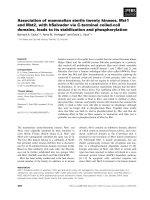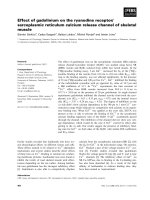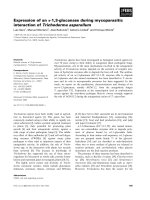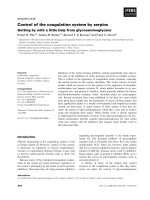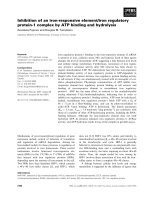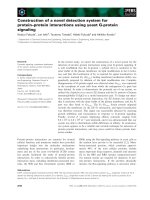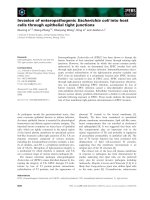báo cáo khoa học: " Engineering of an E. coli outer membrane protein FhuA with increased channel diameter" doc
Bạn đang xem bản rút gọn của tài liệu. Xem và tải ngay bản đầy đủ của tài liệu tại đây (551.21 KB, 8 trang )
RESEARCH Open Access
Engineering of an E. coli outer membrane protein
FhuA with increased channel diameter
Manuel Krewinkel, Tamara Dworeck and Marco Fioroni
*
Abstract
Background: Channel proteins like FhuA can be an alternative to artificial chemically synthesized nanopores. To
reach such goals, channel proteins must be flexible enough to be modified in their geometry, i.e. length and
diameter. As continuation of a previous study in which we addressed the lengthening of the channel, here we
report the increasing of the channel diameter by genetic engineering.
Results: The FhuA Δ1-159 diameter increase has been obtained by doubling the amino acid sequence of the first
two N-terminal b-strands, resulting in variant FhuA Δ1-159 Exp. The total number of b-strands increased from 22 to
24 and the channel surface area is expected to increase by ~16%. The secondary structure analysis by circular
dichroism (CD) spectroscopy shows a high b-sheet content, sugg esting the correct folding of FhuA Δ1-159 Exp. To
further prove the FhuA Δ1-159 Exp channel functionality, kinetic measurement using the HRP-TMB assay (HRP =
Horse Radish Peroxidase, TMB = 3,3’,5,5 ’-tetramethylbenzidine) were conducted. The results indicated a 17% faster
diffusion kinetic for FhuA Δ1-159 Exp as compared to FhuA Δ1-159, well correlated to the expected channel
surface area increase of ~16%.
Conclusion: In this study using a simple “semi rational” approach the FhuA Δ1-159 diameter was enlarged. By
combining the actual results with the previous ones on the FhuA Δ1-159 lengthening a new set of synthetic
nanochannels with desired lengths and diameters can be produced, broadening the FhuA Δ1-159 applications. As
large scale protein production is possible our approach can give a contribution to nanochannel industrial
applications.
Keywords: Channel proteins, FhuA, liposomes, protein engineering, HRP, TMB-Assay, nanocontainers
Background
Integral outer membrane proteins of gram negative bac-
teria use amphiphatic b-sheets to traverse lipid mem-
branes. b-barrel proteins consisting of 8, 12, 14, 10, 18
and 22 strands are known. All members of the above
mentioned family are cylindrical, closed barrels with an
even number of transmembrane b-strands that are con-
nected in a b-meander topology with alternating tight
turns and longer connecting loops [1]. The b-strand
contribution to the overall secondary structure of these
proteins is usually high (~ 60%) [ 1-5]. The respective
membranes are spanned by b-strands of 9-11 residu es.
The smallest known barrel (i.e. OmpA) contains 8 trans-
membrane strands; due to packing constraints in the
barrel interior, this might mark the lower possible size
limit [2]. The largest known b-barrel proteins contain
22 strands (i.e . TonB dependent importers). However
thereissomeevidencefortheexistenceofevenlarger
b-barre ls [3]. In general the hydrophobic and mem-
brane-interacting surface of b-barrelproteinsiscrypti-
cally encoded in their primary sequence [4].
Apart from their biological importance, one applica-
tion of bacterial membrane proteins with b-barrel struc-
ture is the channel functionalization of lipid or block
copolymer based membranes. So far the bacterial
nucleoside transporter Tsx, w hich is one of the smaller
b-barrel proteins with 12 antiparallel s trands [5], the E.
coli outer membrane protein F (OmpF), with 16 antipar-
allel b-strands [6], the E. coli mechanosensitive channel
protein MscL and one of the largest b- barrel proteins,
the E. coli Ferric hydroxamate protein uptake compo-
nent A (FhuA) have been successfully inserted into lipid
* Correspondence:
Department of Biotechnology (Biology VI), RWTH Aachen University,
Worringerweg 1, 52074 Aachen, Germany
Krewinkel et al. Journal of Nanobiotechnology 2011, 9:33
/>© 2011 Krewinkel et al; licensee BioMed Central Ltd. This is an Open Access article dis tributed under the terms of the Creative
Commons Attribution License ( which permits unrestrict ed use, distribution, and
reproduction in any medium, provide d the origi nal work is pro perly cited.
or polymer based vesicles [7-9]. Especially the FhuA
proved to be useful, due to its wide channel diameter
and robustness against for instance tryptic digestion
[10].
The E. coli outer membrane protein FhuA is one of the
largest known b-barrel proteins (714 amino acids, ellipti-
cal cross section 39*46 Å), consisting of 22 antiparallel b-
strands con nected by shor t periplasmatic turns and flex-
ible external loops. The protein channel is closed by a
cork domain (amino acids 5-159). Several crystal struc-
tures of the FhuA wild type have been resolved [11,12].
The number of amino acids spanning the outer mem-
brane is 9 to 10 for each b-strand [12]. For biotechnologi-
cal applications one FhuA variant has been engineered in
which the cork domain has been removed (FhuA Δ1-159,
i.e. deletion of amino acids 1 - 159), resulting in a passive
mass transfer channel [13]. The FhuA Δ1-159 variant has
been inserted as a nanochannel triggered by chemical
external stimuli into PMOXA-PDMS-PMOXA [PMOXA
- poly(2-methyl-2-oxazoline); PDMS - poly(dimethyl-
siloxane)] triblock copolymer membranes [14] or lipo-
somes respectively [15]. Very recently FhuA Δ1-159 was
specifically altered to insert it into thick membranes
formed by cheap triblock copolymer PIB
1000
-PEG
6000
-
PIB
1000
(PIB = poly-isobutylene, PEG = poly-ethylen-gly-
col). For this purpose the protein hydrophobic region
was elongated from 3 to 4 nm by “copy-pasting” the last
five amino acids of each b-she et on the periplasmatic
side of the barrel [16].
Previous findings show that FhuA and its variants are
applicable as nanochannels in liposome or polymersome
systems. Furthermore engineered F huA variants can be
an alternative to nanochannels based on artificial b-bar-
rel structures able to insert into the lipid bilayer [17-19].
These artificial and self-assembling b-barrels are based
on rigid rod molecules - extremely r igid, synthetic rod-
shaped molecules with great potential i n material
sciences - combined with short peptide str ands. Artifi-
cial b -barrels can in principle be tailored in size and
functional groups [17,20]. However the synthesis of
the se mol ecules is not t rivial and large scale production
is difficult [17]. Furthermore the peptide sequence vari-
ety is until now very limited and each artificial b-barrel
contains only one kind of peptide sequence [21,22].
To overcome the limitations in synthesis and related
scale up, the use of b-barrel proteins modified by
genetic engineering techniques can be considered a valid
alternative.
Here we report for the first time the successful re-
engineering of a channel protein with b-barrel structure
leading to an increase in channel diameter. The channel
diameter of FhuA variant Δ1-159 was increased by addi-
tion of two b-strands to the protein primary sequence.
As the folding information is intrinsically contained in
the primary sequence, it seemed most promising to
copy a part of the already existing sequence, therefore
the first N-terminal b-sheet was doubled to reach FhuA
variant Δ1-159 Exp (expanded diameter). The FhuA Δ1-
159 Exp seco ndary structure was analyzed by circular
dichroism (CD). To demonstrate the functionality of
FhuA Δ1-159 Exp as a channel, kinetics for TMB
(3,3’,5,5’ -tetramethylbenzidine) uptake by HRP (Horse
Radish Peroxidase) loaded liposomes with inserted open
and biotin label-closed FhuA Δ1-159 Exp channel were
measured. The kinetic data were compared to results of
identically carried out experiments with FhuA Δ1-159.
Results and Discussion
FhuA Δ1-159 Exp conceptual and estimated increase in
diameter
The a im was to increase the inner channel diameter of
E. coli outer membrane protein FhuA Δ1 -159, by the
addition of a further b-sheet. A conservative approach
was chosen, starting with the addition of only two
strands, without introducing entirely new sequence
information, but rather by copy-pasting 30 amino acids
of the existing sequence. The first two strands on the
N-terminus were chosen (Figure 1), as they are
Figure 1 Schematic representation of FhuA Δ 1-159 Exp design. Schematic picture of FhuA Δ 1-159 Exp secondary structure as it transverses
the membrane (depicted in grey). Membrane spanning b-strands are marked in orange, outside loops (L1’ - L11) in green and periplasmic turns
(T1’ - T11) in turquoise. The two N-terminal doubled b-strands as well as the associated turns and loops are depicted in red.
Krewinkel et al. Journal of Nanobiotechnology 2011, 9:33
/>Page 2 of 8
connected by one of the shortest loops. The N-terminal
sequence is preserved and thus N- and C-terminus are
still expected to close to the intact barrel structure.
Furthermore the chosen b-stands are rather suited for
duplicating, as they are composed 61% of amino acids
that promote b-sheet formation [23].
Since the FhuA shows a nearly circular morphology
[11,12], a simple regular polygonal geometry (hendeca-
gon for FhuA Δ1-159 and dodecagon for FhuA Δ1-159
Exp), with constrained side length given by the hydro-
gen bond co nnecting the b-sh eets, can be ass umed (Fig-
ure 2). Based on this assumption the relative expected
diameter increase can be calculated, as the FhuA wild
type (WT) channel diameter with 22 b-sheets is known
to be ~4.2 nm as deduced from crystal structure [11,12].
Knowing the apothem of FhuA WT, the expected FhuA
Δ1-159 Exp pore cross section is ~4.6 nm as calculated
from the apothem ratio. Thus the channel surface area
increases by 16% upon addition of two b-strands (see
also Additional File 1 Table S1).
Extraction and Purification of FhuA Δ1-159 Exp
Detergent extraction led to FhuA Δ1-159 Exp solubi-
lized in buffer containing detergent oPOE (n-octylpo-
lyoxyethylene). The sample contained many impurities
(whole protein content: ~1800 μg/ml) and was there-
fore discarded. Second extraction step using the deter-
gent OES (n-octyl-2-hydroxyethylsulfoxide) led to
~420 μg/ml of FhuA Δ1-159 Exp (Figure 3). ImageJ
( analysis resulted
in a FhuA Δ1-159 Exp purity of ~80-90% for the OES
solubilised sample. The ImageJ program converts
photographic plates (analogic) to a digitalized matrix
where to each pixel (x axis) is assigned a value, 0 for
white and 1 for black passing through a grey scale (y
axis). The total area or number of pixels with values >
0 corresponds to the protein bands on a SDS gel
within one lane and is normalized to 100%. At this
point the relative purity of a protein in the same lane
is simply deduced by determining the ratio between
the number of pixels > 0 corresponding to the interest-
ing protein band and the number of pixels > 0 of all
bands in the lane.
CD Spectra of FhuA Δ1-159 Exp
Based on the observation that the o riginal FhuA Δ1-159
is able to independently refold after thermal denatura-
tion (unpublished data from the authors) or when
extracted from inclusion bodies [24], showing that fold-
ing information is fully contained within the primary
sequence [4], the FhuA Δ1-15 9 Exp was expected to
fold as a b-barrel.
The secondar y structure analysis of FhuA Δ1-159 Exp
by circular dichroism (CD) gives clues on whether the
applied engineering strategy to widen the inner protein
channel diameter leads still to a b-sheet folding.
In agreement with previous C D results obtained for
WT, FhuA Δ1-159 as well as WT crystal structure [11],
the secondary structure of FhuA Δ1-159 Exp is well
retained as shown in Figure 4.
The CD derived amount of b-structure for FhuA WT
is 51% [14], while for FhuA Δ1-159 values between 49%
and 65% have been reported [24,25].
The deconvolved dichroic spectra using the CONTIN
[26] method report a 63% of b-strand, 30% random coil
and 7% a-he lical contribution for the FhuA Δ1-159 Exp
(data fitting and errors are shown in Additional file 2)
Figure 2 Comparison of FhuA Δ1-159 and FhuA Δ1-159 Exp
channel diameter. FhuA Δ1-159 is represented as a docosagon and
FhuA Δ1-159 Exp as a tetracosagon. The side length is constrained
due to the constrained hydrogen bond length. Increasing the
number of b-strands from 22 (FhuA Δ1-159) to 24 (FhuA Δ1-159 Exp)
leads to an increased diameter, as indicated (Δ d).
Figure 3 SDS-PAGE result of FhuA Δ1- 159 Exp extraction
(using detergent OES). S - sample of FhuA Δ1-159 Exp in OES
(expected size: ~66 kDa). P -lipid fraction pellet remaining after
protein extraction. M - protein molecular weight marker (Fermentas,
St. Leon-Rot, Germany).
Krewinkel et al. Journal of Nanobiotechnology 2011, 9:33
/>Page 3 of 8
and 57% of b-strand, 31% random coil and 12% a-heli-
cal contribution for FhuA Δ1-159 (Figure 4) [24].
Though the secondary structure shows the expected
trend, the CD technique canno t provide information on
a protein tertiary structure thus the b-barrel closing
cannot definitely be proved. In the following section
kinetic studies on liposome inserted F huA Δ1-159 Exp
addr ess the channel functionality and suggest a b-barrel
folding.
Influx kinetics and TMB/HRP detection system
To verify whether FhuA Δ1-159 Exp is functio nal, the
protein was reconstituted into liposomes made of E. coli
lipid extract. The channel functiona lity was analysed
with the help of the HRP/TMB assay system. This
method was a lready applied in order to study the chan-
nel properties of membrane isolated FhuA Δ1-159 [15].
The TMB/HRP is a widely used enzymatic assay, its
detection system is based on a two-step irreversible con-
secutive reaction A®B ®C(A=TMB;BandC=first
and secon d TMB oxidation pro ducts) catalysed b y
enzyme HRP in presence of H
2
O
2
. Since the final TMB
oxidation product C is only stable under very acidic
conditions (0.3 Mol/L H
2
SO
4
) [27], the intermediate
product (B) is used as a reporter with a characteristic
absorbance maximum at 370 and 652 nm. TMB oxida-
tion kinetics were quantified by measuring absorption at
652 nm over a time of 9 min.
The HRP was encapsulated into liposomes and despite
of using the Soret absorption band, the total amount of
encapsulated enzyme could not be detected.
The kinetic data obtained in presence of the FhuA Δ1-
159 Exp, were compared to a negative control consisting
of HRP loaded liposomes, to verify t he obtained results.
Empty liposo mes were used as a blank as they show no
kinetics and their self-absorption was subtracted from
all kinetic data.
Overall kinetic data are reported in Figure 5.
Since the lipid membane is not entirely impermeable,
liposomes lacking the channel protein show slow TMB
conversion kinetics (Figure 4, squares), however TMB
conversion of lipid vesicles with inserted FhuA Δ1-159
Exp (Figure 4, crosses ) occurs ~11-times faster. A linear
regression using “least square” method was performed
to find the best linear section in the ste epest region of
both curves, to determine the absorbance time deriva-
tive (see details in Additional File 1, Figure S2). Lambert
Beer Law was used to calculate the TMB conversion
speed in nM/sec (Table 1) [24]. To address the question
whether the FhuA Δ1-159 Exp truly acts as a channel or
whether the liposome membrane gets locally perturbed
bythepresenceoftheprotein,FhuAΔ1-159 Exp was
blocked by biotinylation of the 31 Lys-NH
2
groups,
using a technique that has already be en applied to block
the FhuA Δ1-159 [14,15] and FhuA Δ 1-159 Ext [16]
(see next paragraph).
The previous experiments showed the ability of chan-
nel Lys-NH
2
group biotinylation to efficiently close the
channel in case o f FhuA Δ1-159 (means no detectable
substrate conversion) or to at least a partial closing of
the channel in case of the el ongated FhuA Δ1-159 Ext
(means drastical decrease of substrate conversion speed).
In comparison to liposomes harbouring the open
FhuA Δ1-159 Exp, liposomes with the blocked channel
protein show a ~3 times smaller slope and TMB conver-
sion rate (Figure 4, black triangles) (see Additional File
1, Figure S2). The incomplete channel blocking can be
most likely explained by the expected increase in chan-
nel diameter. As the two extra Lys-NH
2
groups that
were introduced by the addition of two b-strands should
face the channel exterior (as in the original b-strands in
FhuA Δ1-159), labelling of these two functional groups
Figure 4 FhuA Δ 1- 159 Exp CD spectrum and fit.Spectrumwas
obtained in a potassium phosphate solution (0.1 M, pH 7.4)
containing 0.5% (w/v) of OES detergent.
Figure 5 Results of TMB conversion kinetics.HRPloaded
liposomes (squares), HRP loaded liposomes with reconstituted FhuA
Δ1-159 Exp (crosses) and HRP loaded liposomes with label blocked
FhuA Δ1-159 Exp (triangles).
Krewinkel et al. Journal of Nanobiotechnology 2011, 9:33
/>Page 4 of 8
can therefore give no contribution to the blocking. The
possibility that not all 31 Lys-NH
2
groups were labelled
could be excluded by determining the overall amount of
biotin labels present on the protein (as described in the
next section: “ Quantitative determination of the biotiny-
lated Lys”) and comparing to expected theoretical
amount of labels.
A comparison of FhuAΔ1- 159 Exp kinetic da ta and
data obtained for FhuA Δ1-159 as derived from a pre-
vious study [24] is shown in Table 1. It shows that TMB
convers ion and therefore TMB translocation through the
liposomes inserted FhuA Δ1-159 Exp occurs ~1.2-times
(17%) faster as compared to FhuA Δ1-159, this can be
correlated to the expected channel surface area increase
of 16% (see Figure 2 and Additional File 1, Table S1).
In fact due to the first Fick’s law, the total flux is pro-
portional to the diffusion coeff icient and the concentra-
tion gradient. As both variables were controlled by the
experimental conditions maintaining the same values via
the substrate concentration, the ratio (17%) between the
two fluxes measured for the FhuA Δ1-159 and FhuA
Δ1-159 Exp are only proportional to the surface areas of
the two channel with different diameters (16% higher
for FhuA Δ1-159 Exp).
TMB conversion through the biotinylat ed FhuA Δ1-
159 Exp takes place ~3.7-times faster than in case of the
labelled FhuA Δ1-159, showing ones more that the
increase in in ner channel diameter leads to less efficient
closing of FhuA Δ1-159 Exp.
Theobservedincreaseindiffusionkineticsthrough
FhuA Δ1-159 Exp as compared to FhuA Δ1-159
strongly suggest that the addition of the two b-strands
led to a diameter increase thus implying the correct
folding of added b-strands.
This conclusion is based on the assumption that the
number of channel proteins per liposome (FhuA Δ1-159
and FhuA Δ1-159 Exp) are equal. Unfortunately we
have not been able to demonstrate this equality in the
number.
Therefore the good correlation between channel sur-
face area in crease and kinetic results can be either due
to an increase in channel diameter or to an unlikely
increase in the number of inserted protein channels of
exactly 16%.
Quantitative determination of the biotinylated Lys
(biotinylation assay)
Deter mination of the nu mber of effectively labelled Lys-
NH
2
groups present in the FhuA Δ1-159 Exp gives a
clue on whether the differences in FhuA Δ1- 159 Exp
influx kinetics are due to insufficient labelling or rather
and as expected to the diameter increase. FhuA Δ1-159
Exp contains 31 Lys residues in total. An average b iotin
concentration of ~4000 pmol was found after proteolytic
digestion of the labelled FhuA Δ1-159 Exp (exposing all
biotin moieties), matching the theoretical biotin label
concentration of 4185 pmol in case all 31 Lys are
labelled (see paragraph “Biotinylation Assay” in Addi-
tional File 1). Therefore the residual kinetics cannot be
accounted to a partial FhuA Δ1-159 Exp labelling.
Conclusions
Recently many efforts have been devoted to obtain syn-
thetic pores with b-barrel conformation having vast
technological application ranging from drug-release,
host sensors and catalysis [18]. These artific ial b-barrels
can in principle be tailored in size and functional groups
[17,20]. An alternative strategy involves the engineering
of bacterial b- barrel proteins that can be altered in the
geometry (diameter, length) and functional groups. A
first step in the direction of biological b-barrels with tai-
lored geometry is the previously reported increase of the
FhuA Δ1-159 length by 1 nm [16].
In this study in order to complete the channel geome-
try engineering, the FhuA Δ1-159 area was increased by
16% by increasing the number of b-strands from 22 to
24. To our knowledge this is the first time, besides our
previous study [16], a channel protein was specifically
engineered to modify its geometry.
Asimple“copy-paste” strategy applied to the first two
b-strands at the FhuA Δ1-159 N-terminus has been
developed, resulting in protein variant FhuA Δ1- 159
Exp (Expanded). In order to minimize the probability of
incorrect protein folding a conservative approach has
been followed by adding only two b -strands. The pasted
amino acids are expected to lead to the same folding as
the original ones, as the folding information is fully con-
tained in the primary sequence [4]. Considering the
cross section of FhuA Δ1-159 Exp as circular, the chan-
nel diameter was increased by 0.4 nm.
FhuA Δ1-159 Exp was functionally embedded into
liposome membranes as confirmed by HRP/TMB a ssay
kinetic studies. Furthermore the kinetic studies revealed
an increase in diffusion kinetics of 17% for FhuA Δ1-
159ExpascomparedtodataobtainedforFhuAΔ1-
Table 1 Comparison of FhuA Δ1-159 and FhuA Δ1-159
Exp (unblocked and blocked) average TMB conversions
in liposomes
Sample TMB conversion
[nM]/sec
Study
Liposomes + HRP + FhuA Δ1-159
Exp
162 ± 3 This study
Liposomes + HRP + FhuA Δ1-159
Exp (blocked)
54 ± 2 This study
Liposomes + HRP + FhuA Δ1-159 139 ± 7 [24]
Liposomes + HRP + FhuA Δ1-159
(blocked)
14 ± 1 [24]
Krewinkel et al. Journal of Nanobiotechnology 2011, 9:33
/>Page 5 of 8
159, well in correlation with the 16% increase in total
channel surface area.
The secondary structure analysis by CD spectroscopy
suggests the correct b-barrel folding of the engineered
FhuA Δ1-159 Exp. Overall results suggest that massive
FhuA Δ1-159 engineering (addition of two b-strands) is
possible without losing channel functionality.
In the future, a combination of the developed FhuA
variants with increased channel length and/or diameter
will give rise to a new set of synthetic channels with
flexible geometry.
Methods
All chemicals were of analytical grade or higher and
purchased from Applichem (Darmstadt, Germany) or
Sigma-Aldrich (St. Louis, USA). Protein concentrations
were determined using the standard BCA kit (Pierce
Chemical Co, Rockford, USA). The oPOE detergent was
obtained from Enzo (Farmingdale, USA), while deter-
gent OES was obtained from Bachem (Bubendorf,
Switzerland).
Construction and cloning of FhuA Δ1-159 Expanded
(FhuA Δ1-159 Exp)
To increase the diameter of the FhuA Δ1-159 the first
two b-sheets (30 additional amino acids in total) of the
protein were copied and pasted to the N-terminus of
the protein (see Figure 1).
After gene design and codon op timisation to E. coli
using the Gene Designer software (DNA2.0 2007), the
synthetic gene “fhuA Δ1-159 expanded” (fhuA Δ1-159
exp) was purchased from Mr. Gene (Regensburg, Ger-
many). The synthetic gene (see paragraph “ DNA
sequence of FhuA Δ1-159 Exp”, Additional File 1 ) was
subcloned into the E. coli expression vector pBR-IBA1
(IBA, Göttingen, Germany) resulting in plasmid pBR-
IBA1 fhuA Δ1-159 exp.
Expression and Extraction of FhuA Δ1-159 Exp
FhuA Δ1-159 Exp was expressed in E. coli BE strain
BL 21 (DE3 ) omp8 ( F- hsdSB (rB- mB) gal ompT dcm
(DE3) ΔlamB ompF::Tn5 ΔompA ΔompC)[29]as
described previously [7] with some minor changes.
Several colonies of freshly transformed E. coli omp8
cells were inoculated into 20 ml NaPY
Amp
medium
[30]. This pre-culture was grown over night at 3 7°C.
The main-culture was inoculated from the pre-culture
to an initial OD
600
of 0.2. Expression was p erformed
in 200 ml NaPY
Amp
medium at 30°C. Protein expres-
sion was induced by adding 1 mM IPTG at an OD
600
of 0.7-0.8. The expression level of Fhu A Δ1-159 Exp
was monitored by SDS PAGE (see section SDS
PAGE). After reaching stationary phase cells were har-
vested by centrifugation at 3.300 × g, 4°C, 15 min and
the resulting pellet was stored at -20°C until protein
extraction.
FhuA Δ1-159 Exp was extracted from the E. coli outer
membrane as previously described [31] with slight
changes. All amounts are given for a pellet obtained
from a 200 ml cell culture with an OD
600
of 3.0.
The cell pellet was resuspended in 10 ml lysis buffer
(0.1 M phosphate-buffer, pH 7.4; 2.5 mM MgCl
2
;0.1
mM CaCl
2
). By the use of a high pressure homogeniza-
tor (EmulsiFlex-C3, Avestin, Ottawa, Canada ) the cells
were broken. Thereafter 1 ml of extraction buffer (0.1
M phosphate-buffer, pH 7.4; 2.5 mM MgCl
2
;0.1mM
CaCl
2
; 20% v/v Triton X-100) was added and samples
were incubated while shaking at 37°C for 1 hour. After
incubation the solution was ce ntrifuged at 38000 × g, 4°
C for 45 min. Supernatant was discarded and the pellet
was washed 3 times with washing buffer (0.1 M phos-
phate-buffer, pH 7.4) without resuspending it. The
remaining pellet was homogenized in 1.5 m l pre-extrac-
tion buffer (0.1 M phosphate-buffer, pH 7.4; 1 mM
EDTA; 0.1% v/v oPOE) using a tissue grind tube. After-
wards the solution was incubated at 37°C for 1 hour
and the next centrifugation was carried out at 170000
xg, 4°C for 45 min (Beckmann Coulter Optima™,L-
100-XP Ultracentrifug e, California USA). Again the pel-
let was resuspended using the tissue grind tube in 1.5
ml solubilisation buffer (0.1 M phosphate-buffer, pH 7.4;
1 mM EDTA; 3.0% v/v oPOE) and incubated for 1 hour
at 37°C. The last centrifugation step was performed at
170000 xg, 12°C for 45 min (Beckmann Coulter
Optima™, L-100-XP Ultracentrifuge, California USA) to
obtain the FhuA Δ1-159 Exp protein in the supernatant.
At all steps 1 μl phenylmethanesulfonyl fluorid ( PMSF;
protease inhibitor) was added.
From each pellet and super natant samples were taken
and analyzed on SDS gel.
To increase the FhuA Δ1-159 Exp yield, the residual
pellet from the oPOE-extraction was used for further
extraction with the detergent O ES [32]. Therefore the
pellet was resuspended in 1.5 ml OES-solubilisation buf-
fer (0.1 M phosphate-buffer, pH 7.4; 1 mM EDTA; 0.5%
w/v OES) using the tissue grind tube. After proper
resuspension the soluti on was incubated 1 hour at 37°C
with shaking. Subsequently it was centrifuged at 170000
xg, 12°C for 45 min to obtain the FhuA Δ1-159 Exp
protein in the supernatant.
The purified FhuA Δ1-159 Exp was loaded onto a 10%
SDS acrylamide gel [33]. After electrophoresis the pro-
tein was stained by Coomassie Brilliant blue R-250.
SDS-PAGE
SDS polyacrylamide gel elec trophoresis utilizing gels
consisting of a 10% w/v acrylamide separation gel with a
5% w/v acrylamide stacking gel were used to monitor
Krewinkel et al. Journal of Nanobiotechnology 2011, 9:33
/>Page 6 of 8
the protein expressions as well as to evaluate the quality
of protein purification. Bands were visualized by Coo-
massie staining [33].
Secondary structure determination of FhuA Δ1-159 Exp
by circular dichroism (CD) spectroscopy
Dichroic spectra were measured with an Olis DSM 17
CD spectrophotometer (Olis, Bogard, USA). Samples
were pipetted into a Suprasil QS cuvette (Hellma,
Müllheim, Germany) with a pathlenght of 0.5 nm. For
each samples five spectra from 190 nm to 240 nm
were collected and averaged. Background spectra using
the buffer, in which the protein was solved, were
subtracted.
Spectra were analyzed to calculate the a-helix, b-bar-
rel and random coil secondary structure content by
using the Dicroprot deconvolution program [34] and the
CONTIN algorithm [35].
Liposome preparation
Liposomes were formed using the film hydration
method [15] followed by a filter extrusion process and
finally a size exclusion chromatography (SEC) for homo-
genization and purification.
For the lipid film preparation 500 μ lofE. coli total
lipid extract (10 mg) dissolved in chloroform (Avanti
Polar Lipids, Alabasta, USA) were mixed 1:1 with
methanol. The organic solvents were evaporated in a
round bottom flask using a vacuum evaporator (VWR,
Darmstadt, Germany) to create a lipid film in the flask.
HRP (horse radish peroxidase) loaded liposomes were
obtained by adding 1 m l of an aqueous buffer solutio n
(0.1 M potassium phosphate-buffer, pH 7.4) containing
HRP (2.9 U/ml) to the lipid film. Liposomes with
entrapped HRP and membrane inserted FhuA Δ1-159
Exp (2.7 μM) or FhuA Δ1-159 (2.7 μM) respectively
(aswellasLys-NH
2
labeled forms of both channel pro-
teins) were prepared by adding 1 ml buffer (0.1 M
potassium phosphate-buffer, pH 7.4) containing HRP
(2.9 U/ml) as well as the protein to insert (2.7 μM) to
the previously formed lipid film. Empty liposomes as
they were used as negative controls, were rehydrated
by the addition of 1 ml buffer (0.1 M potassium phos-
phate-buffer, pH 7.4). Liposomes were then formed via
rehydration, under slow rotation of the round bottom
flasks. Lipid film preparati on and rehydration were car-
ried out over night.
Rehydrated liposomes were sequentially ex truded with
an Avanti polar lipids extruder (Avanti P olar Lipids,
Alabasta, USA) with 1 μm, 0.4 μmand0.2μmmem-
branes (Millipore, Bedford, USA) to uniform the nano-
compartments in size and shape [36]. Purification was
carried out through size exclusion chromatography
(SEC).
Size exclusion chromatography (SEC) for liposome
purification
All five subsets of produced nanocompartments (lipo-
somes without inserted channel protein, liposomes with
inserted FhuA Δ1-159 Exp as well as liposomes with
inserted FhuA Δ1-159 and the labelled forms of both
channel proteins) were purified by gel filtration using
Sepharose 6B (Sigma-Aldrich, Cat. no. 6B100-500 ML)
in phospha te buffer (0.1 M potassium phosphate-buf fer,
pH 7.4).
First the SEC column was saturated with liposomes to
avo id unspecific bindi ng to the matrix. Afterwards lipo-
somes obtained from the extrusion process were loaded.
Fractions of 750 μl were collected and A verage dia-
meters of nanocompartments were routinely determined
using a Zeta-Sizer (Zeta-Sizer Nano Series; Malvern,
Worcestershire, UK//Supp. Mat.: Additio nal File 1, Fig-
ure S1).
TMB assay with liposomes
As a reporter system for compound influx into th e lipo-
somes a colorimetric TMB conversion assay w as used.
Since in all types of prepared liposomes HRP is encap-
sulated in the lumen TMB gets converted in a two-step
oxidation reaction into a blue (E = 650 nm) and subse-
quently yellow (E = 420 nm) product after entering the
liposome.
To 50 μl of liposome solution (normalized to a OD
600
of 0.04/ml) and 50 μl of phosphate buffer (0.1 M phos-
phate-buffer, pH 7.4) 20 μl of TMB-substrate solution
(readymade TMB/H
2
O
2
solution; Sigma-Aldrich, St.
Louis, USA) were added. TMB oxidation kinetics was
monitored at 650 nm in a Tecan Infinate M1000 spec-
trofluorometer (Tecan, Männedorf, Switzerland).
FhuA Δ1-159 Exp and FhuA Δ1-159 labelling
In order to biotinylate the Lys-NH
2
groups present on
FhuA Δ1-159 Exp and FhuA Δ1-159, a 20% DMSO aqu-
eous solution containing (2-[Biotinamido]ethylamido)-
3,3’-dithiodipropionic acid N-hydroxysuccinimide ester)
(8.2 mM) was added drop-wise to 1200 μl of a FhuA
Δ1-159 Exp or FhuA Δ1-159 solution respectively and
stirred (3000 rpm, 1 h; RCT basic IKAMAG, IKA-
Werke GmbH, Staufen, Germany). The latter solution
was used for the formation of liposomes, as described
above as well as for the biotinylation assay.
Quantitative determination of the biotinylated Lys
(biotinylation assay)
The determination of the biotinyl groups present o n the
FhuA Δ1-159 Exp a nd FhuA Δ1-159 protein has been
performed using the Invitrogen FluoReporter
®
Biotin
Quantitation Assay Kit specifically developed for pro-
teins. Fluorescence was detected by a Tecan
Krewinkel et al. Journal of Nanobiotechnology 2011, 9:33
/>Page 7 of 8
Spectrofluoromete r (Infinite
®
1000, Tecan Group Ltd.,
Männedorf Switzerland).
Additional material
Additional file 1: • Liposome DLS Data. • FhuA Δ1-159 Exp estimated
increase in diameter • HRP Assay • Biotinylation Assay • DNA sequence of
FhuA Δ1-159 Exp.
Additional file 2: • CD data and CONTIN deconvolution output for
FhuA Δ1-159 Exp.
Acknowledgements
MK acknowledge Prof. Ulrich Schwaneberg and RWTH Aachen University for
the possibility to develop this work.
Authors’ contributions
MK and TD carried out design and performed study, data analysis and
drafting of the manuscript.
MF designed research.
All author’s read and approved the final manuscript.
Competing interests
The authors declare that they have no competing interests.
Received: 14 July 2011 Accepted: 19 August 2011
Published: 19 August 2011
References
1. Schulz G: Porins: general to specific, native to engineered passive pores.
Curr Opin Struct Biol 1996, 6:485-490.
2. Kleinschmidt JH, KT T: Secondary and tertiary structure formation of the
b-barrel membrane protein OmpA is synchronized and depends on
membrane thickness. J Mol Biol 2002, 324:319-330.
3. Ramachandran R, Heuck AP, Tweten RK, Johnson AE: Structural insights
into the membrane-anchoring mechanism of a cholesterol-dependent
cytolysin. Nat Struct Biol 2002, 9:823-827.
4. Wimley C: The versatile beta-barrel membrane protein. Curr Opin Struc
Biol 2003, 13:404-411.
5. Ye J, van den Berg B: Crystal structure of the bacterial nucleoside
transporter Tsx. EMBO J 2004, 23:3187-3195.
6. Cowan SW, Garavito RM, Jansonius JN, Jenkins JA, Karlsson R, Konig N,
Pai EF, Pauptit RA, Rizkallah PJ, Rosenbach JP: The structure of OmpF porin
in a tetragonal crystal form. Structure 1995, 3:1041-1050.
7. Nallani M, Benito S, Onaca O, Graff A, Lindemann M, Winterhalter M,
Meier W, Schwaneberg U: A nanocompartment system (synthosome)
designed for biotechnological applications. J Biotechnol 2006, 123:50-59.
8. Ranquin A, Versees W, Meier W, Steyaert J, Van Gelder P: Therapeutic
nanoreactors: combining chemistry and biology in a novel triblock
copolymer drug delivery system. Nano Lett 2005, 5:2220-2224.
9. Surrey T, Schmid A, Jähnig F: Folding and membrane insertion of the
trimeric beta-barrel protein OmpF. Biochemistry 1996, 35:2283-2288.
10. Hoffmann H, Fischer E, Schwarz H, Braun V: Overproduction of the
proFhuA outer membrane receptor protein of Escherichia coli K-12:
isolation, properties, and immunocytochemical localization at the inner
side of the cytoplasmic membrane. Arch Microbiol 1986, 145:334-341.
11. Ferguson A, Braun V, Fiedler H-P, Coulton J, Diederichs K, Welte W: Crystal
structure of the antibiotic albomycin in complex with the outer
membrane transporter FhuA. Prot Sci 2000, 9:956-963.
12. Ferguson A, Hofmann E, Coulton J, Diederichs K: Siderophore-mediated
iron transport: crystal structure bound lipopolysaccharide. Science 1998,
282:2215-2220.
13. Braun M, Killmann H, Maier E, Benz R, Braun V: Diffusion through channel
derivatives of the Escherichia coli FhuA transport protein. Eur J Biochem
2002, 269:4948-4959.
14. Onaca O, Sarkar P, Roccatano D, Friedrich T, Hauer B, Grzelakowski M,
Güven A, Fioroni M, Schwaneberg U: Functionalized nanocompartments
(Synthosomes) with a reduction-triggered release system. Ang Chem Int
Ed 2008, 47
:7029-7031.
15. Güven A, Fioroni M, Hauer B, Schwaneberg U: Molecular understanding of
sterically controlled compound release through an engineered channel
protein (FhuA). J Nanobiotech 2010, 8(14).
16. Muhammad N, Dworeck T, Fioroni M, Schwaneberg U: Engineering of the
E. coli Outer Membrane Protein FhuA to overcome the Hydrophobic
Mismatch in Thick Polymeric Membranes. J Nanobiotech 2011, 9(8).
17. Baumeister B, Matile S: Rigid-rod beta-barrels as lipocalin models: probing
confined space by carotenoid encapsulation. Chem - Eur J 2000,
6:1739-1749.
18. Sakai N, Matile S: Synthetic multifunctional pores: lessons from rigid-rod
beta-barrels. Chem Commun 2003, 2514-2523.
19. Schwab PFH, Levin MD, Michl J: Molecular rods. 1. Simple axial rods.
Chem Rev 1999, 99:1863-1934.
20. Litvinchuk S, Bollot G, Mareda J, Som A, Ronan D, Shah MR, Perrottet P,
Sakai N, Matile S: Thermodynamic and kinetic stability of synthetic
multifunctional rigid-rod β-barrel pores: evidence for supramolecular
catalysis. J Am Chem Soc 2004, 126:10067-10075.
21. Kumaki J, Yashima E, Bollot G, Mareda J, Litvinchuk S, Matile S: AFM
snapshots of synthetic multifunctional pores with polyacetylene
blockers: Pseudorotaxanes and template effects. Angew Chem, Int Ed
2005, 44:6154-6157.
22. Litvinchuk S, Matile S: Blockage of rigid-rod beta-barrel pores by rigid-rod
R-helix mimics. Supramol Chem 2005, 17:135-139.
23. Cantor CR, Schimmel PR: The conformation of biological macromoleculs New
York: W. H. Freeman and Company; 1980.
24. Dworeck T, Petri AK, Muhammad N, Fioroni M, Schwaneberg U: FhuA
Deletion Variant del1-159 Overexpression in Inclusion Bodies and
Refolding with Polyethylene-Poly(ethylene glycol) Diblock Copolymer.
Prot Expr Purif 2011, 77(1):75-79.
25. Boulanger P, le Marie M, Bonhivers M, Dubois S, Desmadril S, Letellier L:
Purification and structural and functional characterization of FhuA, a
transporter of the Escherichia coli outer membrane. Biochemistry 1996,
35:14216-14224.
26. Andrade M, Chacón P, Merelo J, Morán F: Evaluation of secondary
structure of proteins from UV circular dichroism using an unsupervised
learning neural network. Prot Eng 1993, 6:383-390.
27. Josephy P, Eling T, Mason R: The horseradish peroxidase-catalyzed
oxidation of 3,5,3 ’ ,5’-tetramethylbenzidine. Free radical and
chargetransfer complex intermediates. J of Biol Chem 1982, 257:3669-3675.
28. Josephy P, Eling T, Mason R: The horseradish peroxidase-catalyzed
oxidation of 3,5,3’,5’
-tetramethylbenzidine. Free radical and charge-
transfer complex intermediates. J Biol Chem 1982, 257:3669-3675.
29. Prilipov A, Phale P, Koebnik R, Widmer C, Rosenbusch J: Identification and
characterization of two quiescent porin genes, nmpC and ompN, in
Escherichia coli B. J Bacteriol 1998, 180:3388-3392.
30. Onoda T, Enokizono J, Kaya H, Oshima A, Freestone P, Norris V: Effects of
calcium and calcium chelators on growth and morphology of
Escherichia coli L-form NC-7. J Bacteriol 2000, 182(5):1419-1422.
31. Locher KP, Rosenbusch JP: Oligomeric states and siderophore binding of
the ligand-gated FhuA protein that forms channels across Escherichia
coli outer membranes. Eur J Biochem 1997, 247(3):770-775.
32. Locher KP, Rees B, Koebnik R, Mitschler A, Moulinier L, Rosenbusch JP,
Moras D: Transmembrane signaling across the ligand-gated FhuA
receptor: crystal structures of free and ferrichrome-bound states reveal
allosteric changes. Cell 1998, 95:771-778.
33. Laemmli U: Cleavage of structural proteins during the assembly of the
head of bacteriophage T4. Nature 1970, 227:680-685.
34. Deléage G, Geourjon C: An interactive graphic program for calculating
the secondary structures content of proteins from circular dichroism
spectrum. Comput Appl Biosci 1993, 2:197-199.
35. Provencher SW: An eigenfunction expansion method for the analysis of
exponential decay curves. Comput Phys Commun 1982, 27:213-227.
36. Broz P, Benito SM, Saw C, Burger P, Heider H, Pfisterer M, Marsch S,
Meier W, Hunziker P: Cell targeting by a generic receptor-targeted
polymer nanocontainer platform. J Control Release 2005, 102:475-488.
doi:10.1186/1477-3155-9-33
Cite this article as: Krewinkel et al.: Engineering of an E. coli outer
membrane protein FhuA with increased channel diameter. Journal of
Nanobiotechnology 2011 9:33.
Krewinkel et al. Journal of Nanobiotechnology 2011, 9:33
/>Page 8 of 8
